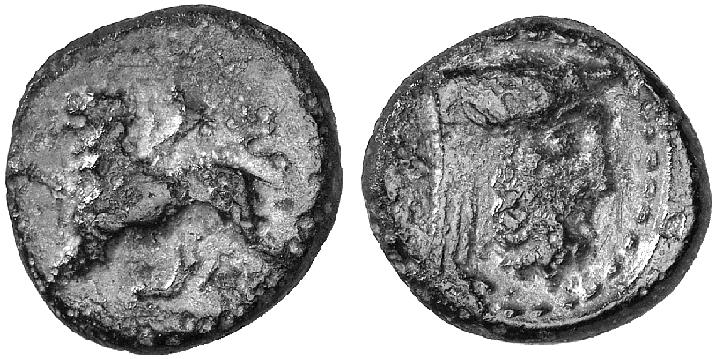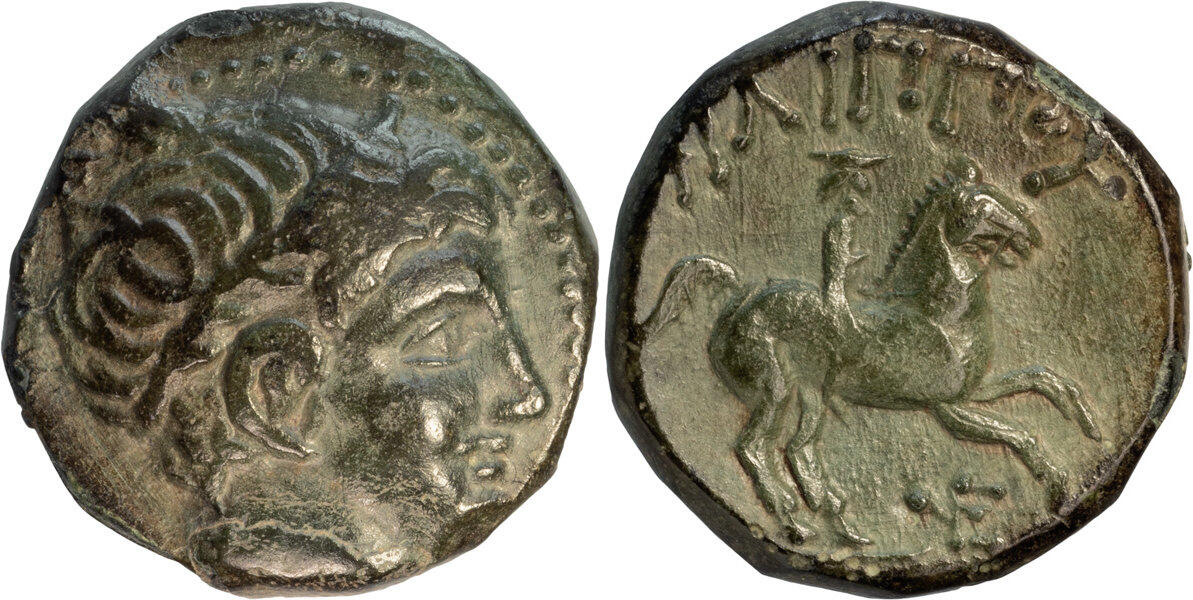Revision as of 14:45, 21 April 2024
280 BCE - 250 BCEMonogram ΛΕ
Overstriking coin
Leucas_Münzen_und_Medaillen, _23, _18_Oct._2007, _n°237.jpg
[1]
Overstruck variety
Philip II Apollo r. rider.jpg
[2]
|
|
Sale(s)Sale(s) ᵖ:
|
Münzen und Medaillen, 23, 18 Oct. 2007, 237
|
|
|
|
Description
| ObverseInscription or printing placed on the obverse.:
|
Monogram ΛΕ (Greek) Chimera left.
|
ReverseInscription or printing placed on the reverse.:
|
Head of bull with man face (Achelaos). In field, monogram. Border of dots.
|
Mint and issuing power
| MintIdentifies the place of manufacture or issue of a numismatic object.:
|
Leucas
|
Ancient regionAncient region.
|
Acarnania
|
Modern countryModern country: Greece
|
AuthorityIdentifies the issuing power. The authority can be "pretended" when the name or the portrait of X is on the coin but he/she was not the issuing power. It can also be "uncertain" when there is no mention of X on the coin but he/she was the issuing power according to the historical sources:
|
|
Chronology
| FromIdentifies the initial date in a range assigned in a numismatic context. 280 BCE toIdentifies the final date in a range assigned in a numismatic context.. 250 BCE
|
Hellenistic 323-30 BC  periodTime period of the numismatic object. periodTime period of the numismatic object.
|
Physical description
MetalThe physical material (usually metal) from which an object is made.: Bronze 
|
WeightWeight of the numismatic object (in grams). in grams: 4.524.52 g <br />4,520 mg <br />
|
|
AxisDescribes the directional relationship between the obverse and reverse of a numismatic object.: 11 mm <br />0.1 cm <br />
|
|
|
|
References
Description
| ObverseInscription or printing placed on the obverse.:
|
Diademed head of Apollo left
|
ReverseInscription or printing placed on the reverse.:
|
ΦIΛIΠΠOY (Greek) Youth on horseback left, below horse
|
Mint and issuing power
Chronology
| FromIdentifies the initial date in a range assigned in a numismatic context. 359 BCE toIdentifies the final date in a range assigned in a numismatic context.. 336 BCE
|
Classical 480-323 BC  periodTime period of the numismatic object. periodTime period of the numismatic object.
|
Physical description
References
References
- ^ Gardner, Percy (1883), A Catalogue of the Greek coins in the British Museum. vol. V : Thessaly to Aetolia, London, The Trustees, p. 234, pl. 32.
- ^ Hoover, Oliver D. (2014), Handbook of Greek Coinage Series 4. Northern and Central Greece : Achaia Phthiotis, Ainis, Magnesia, Malis, Oita, Perrhaibia, Thessaly, Akarnania, Aitolia, Lokris, Phokis, Boiotia, Euboia, Attica, Megaris and Corinthia, sixth to first centuries BC, Lancaster, lxxi, 563 p.
- ^ Troxell, Hyla A. (1994), Sylloge Nummorum Graecorum ANS 8. The Collection of the American Numismatic Society. Macedonia 2. Alexander I - Philip II, New York
- ^ Hoover, Oliver D. (2016), Handbook of coins of Macedon and its neighbors. 3. Part I: Macedon, Illyria, and Epeiros, sixth to first centuries BC, Lancaster, 437 p.

